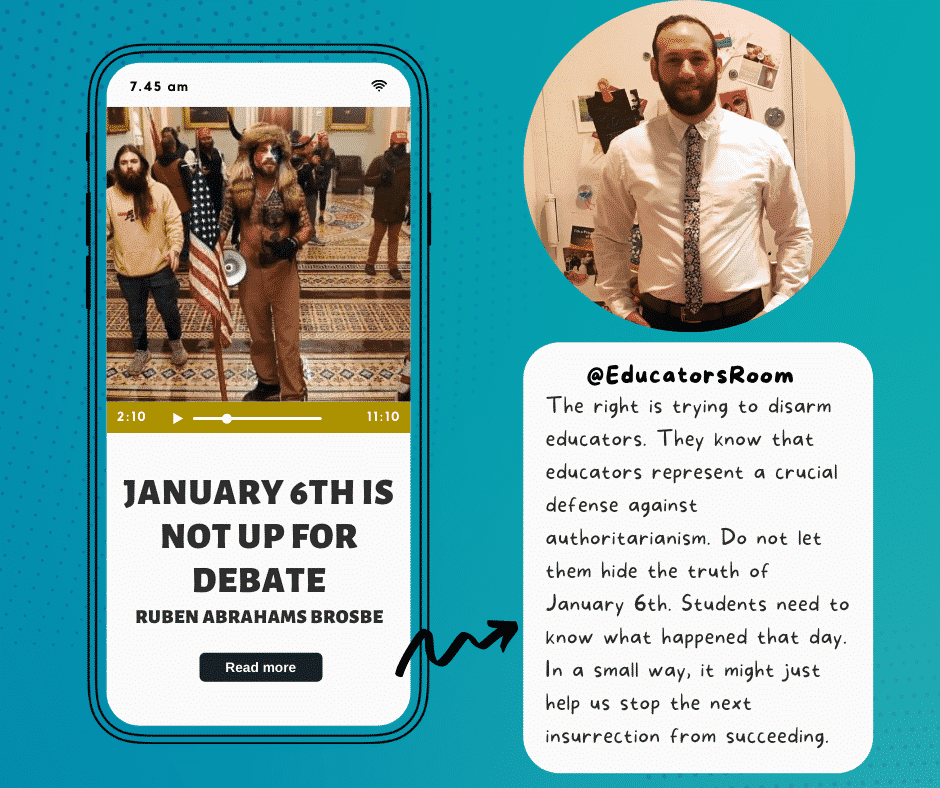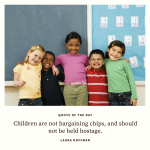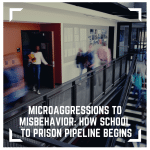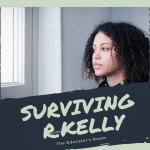Stephen Colbert famously said, “Facts have a well-known liberal bias.” The satirical statement doesn’t feel as funny in the current era of rampant misinformation and The Big Lie. A year ago today, January 6th, a violent attack on the United States Capitol happened. It was a result of a toxic stew cooked up by Donald Trump, social media, and conservative media. In the year since, the same actors are trying to minimize, apologize for, distort, and outright erase the events of that day.
As educators, we have a vital role to play in the defense of our democracy. It is essential that we make it clear that the facts of January 6th are not up for debate.
Teaching Facts is Our Job
Educators are always told our job is to “teach kids how to think, not what to think.” I’ve noticed this rule seems to come up mainly when we’re discussing politics or historical events. I’ve never had anyone take issue with me correcting a student when they tell me 7 x 7 is 50. At the end of the day, part of my job was providing feedback and helping students recognize incorrect information. This is true across subject areas as well as social and emotional learning. It must be true when teaching about January 6th.
It’s also worth noting who are the folks telling us to “shut up and teach.” These are the people who manufactured controversy over critical race theory in schools. The same people crying foul about cancel culture are banning books by LGBTQ+ and BIPOC authors from libraries and classrooms. When we examine who’s demanding “unbiased” teaching that avoids “controversial” topics, we see it is generally wealthy, white men. It is in their self-interest to obscure facts about history and present day systemic oppression.
This orchestrated outrage is all too successful in silencing teachers. We are living at a time when this silence is more dangerous than ever. The cloud of fear hanging over teachers today has been a decades-long project. The pressure to appear unbiased and focused on “how to think” can lead to some flawed teaching. To avoid an attack, some teachers rely on debates and open-ended questions that don’t address the role of racism and other systems of power in our country’s history and present.
The Dangers of Open-Ended Questions and Debates
Imagine a well-intended social studies teacher planning to assign a writing or discussion prompt such as, “The January 6th protestors called themselves patriots. Do you agree or disagree?” This teacher might be hoping to draw attention to the contradiction between some of the insurrectionists’ language and their actions. They might hope students draw comparisons between patriots from U.S. history and the violent mob who attacked the Capitol last year. They may or may not be successful in these goals. But either way, approaching January 6th in an open-ended fashion carries tremendous risks.
The events of January 6th aren’t history yet. But we have already seen the way GOP elected officials, Trump, and others are trying to falsify our national memory of that day. We cannot let what happened on January 6th, become yet another topic of debate. In the same way, the right is trying to erase the evidence of slavery from U.S. history, they are trying to rewrite the meaning of January 6th.
Teach the Facts of January 6th
If you choose to have an open-ended conversation with students about January 6th or other difficult topics, a general framework I have been taught is the following:
First, open up the conversation. “Today is the 1 year anniversary of January 6th. What do you know about what happened last year?” Be ready to correct misinformation. “What do you remember? How do you feel about what happened?” The Morningside Center is a great resource for conversations like this.
If you want to teach directly about January 6th, ground the learning in facts. While we don’t yet know the long-term impact of January 6th, or whether the insurrectionists will try again, there are many things we do know. It is important to establish these facts, precisely because the insurrectionists and their political allies are trying to hide them.
There are many facts you could use to launch a task in practically any subject area. For example, you might present students with information about:
- how many people stormed capitol, how many people were arrested, the racial demographics of the insurrectionists, the cost of property damage, how many deaths and injuries happened, the definition of insurrection, the text of Donald Trump’s speech or other speeches, the timeline of the day’s events, or the presence of white supremacist language and images at the insurrection.
From these facts, there are many open-ended tasks that can follow. But whatever the task, they must be based on the horrifying facts of January 6th.
The right is trying to disarm educators. They know that educators represent a crucial defense against authoritarianism. Do not let them hide the truth of January 6th. Students need to know what happened that day. In a small way, it might just help us stop the next insurrection from succeeding.






